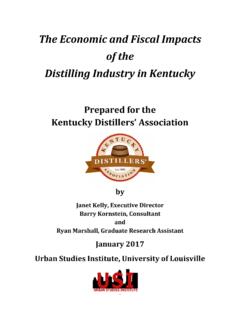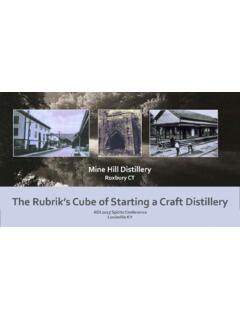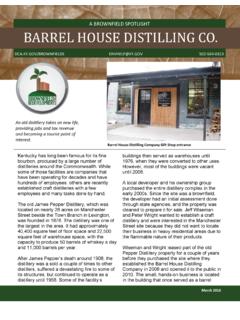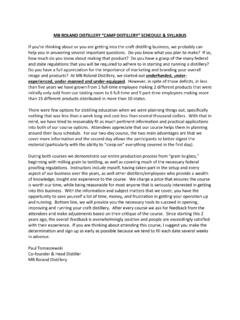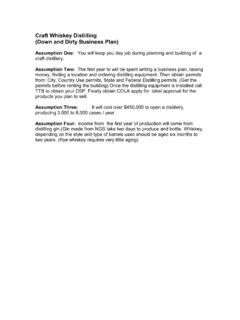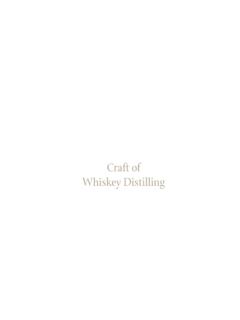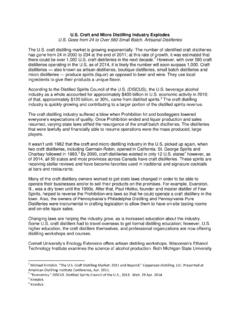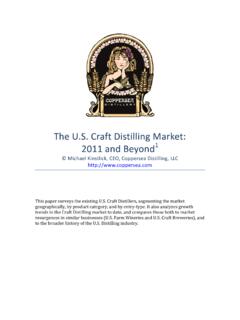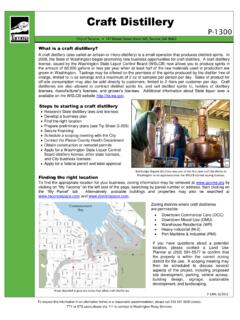Transcription of The Economic and Fiscal Impacts of the Distilling Industry ...
1 The Economic and Fiscal Impacts of the Distilling Industry in Kentucky for the by Barry Kornstein Research Manager with Jay Luckett Graduate Research Assistant Urban Studies Institute, University of Louisville October, 2014 TABLE OF CONTENTS EXECUTIVE SUMMARY .. 1 THE SIZE OF THE Distilling Industry IN KENTUCKY .. 7 Industry definition, number of companies and locations .. 7 Employment and payroll .. 9 Distilling s Share of Kentucky Gross State Product .. 13 Recent investments at Kentucky distilleries .. 14 Craft Distilleries .. 15 Production and sales .. 19 Domestic sales .. 21 Exports .. 22 Economic Impacts .. 22 Linkages to other sectors .. 22 Economic 26 Comparison of Distilling Industry Impacts with other industries .. 28 Total Economic impact of distillery company operations .. 28 impact of construction activity .. 31 impact of capital equipment investment activity.
2 32 Total average annual impact possible from Distilling Industry planned investments .. 33 Potential impact from an increase in local sourcing of grain inputs .. 34 Spent 37 TAXATION AND Fiscal Impacts OF THE Industry .. 38 Property taxes .. 40 Alcohol consumption taxes .. 43 State licenses and fees .. 50 Local licenses and fees .. 51 Tax revenues related to payroll of distilleries .. 51 Comparison to the 2012 study .. 53 THE KENTUCKY BOURBON TRAIL AND ITS TOURISM POTENTIAL .. 54 Sites, visitation data .. 56 Visitor profiles, Impacts .. 57 Other tourism-related activity .. 63 T h e D i s t i l l i n g I n d u s t r y i n K e n t u c k y , 2 0 1 4 Page 1 The Economic and Fiscal Impacts of the Distilling Industry in Kentucky Kentucky is known internationally for its Bourbon whiskey. The state produces and ages perhaps 95 percent of all the Bourbon in the world. Kentucky s distillers are also involved in Distilling other spirits and bottling, packaging and shipping many different kinds of distilled spirits (often distilled elsewhere and brought to Kentucky facilities for final processing).
3 Nearly all of the products are shipped to customers outside of Kentucky, meaning the dollars generated from sales are new to Kentucky. The dollars support the wages, salaries and benefits of workers in the state s Distilling Industry , as well as those employed by suppliers. The dollars circulate further, as employees and owners spend their income in the regional economy, generating jobs and income in grocery stores, car dealers, banks, restaurants, doctors offices, and the like. This study is the third statewide study of the Distilling Industry which we have conducted since 2009. We also analyzed the Distilling Industry in Jefferson County, Kentucky, in 2013. The current study updates and expands on our second statewide study, which we conducted nearly three years ago. We provide a comprehensive statement of the size and Economic importance of the Distilling Industry in Kentucky, including an examination of the burgeoning craft Distilling segment of the Industry .
4 We also look at the Industry s impact on the state s agricultural sector; provide estimates of the state and local government tax revenues associated with the Industry ; a look at Kentucky s tax treatment of the Industry compared to other states; and an estimate of the Economic potential of the emerging Bourbon-tourism component. The Kentucky Agricultural Development Fund contributed funding for the completion of this study. The KADF recognizes the importance Bourbon has on the Commonwealth s agricultural sector and sought to capture the overall Economic impact it brings to Kentucky s farm families. Among the most important and interesting findings are: There are currently 31 companies with Kentucky distiller s licenses. Of those, 26 are either long-enough established that they are listed in the Kentucky Directory of Manufacturers or members of the Kentucky Distillers Association (KDA), the non-profit trade group founded in 1880.
5 The remaining five are small craft distilleries that qualify for the new Class B distiller s license for businesses producing less than 50,000 gallons per year (about 950 Bourbon barrels or 21,000 nine-liter cases). Of the 26 established distillers, 14 also qualify for the new Class B license. The 26 distillers have establishments in 37 locations, situated in 22 cities in 19 counties. The remaining five add four more counties to the list. Our previous study, nearly three years ago, encompassed just 10 companies, with 19 locations in nine cities and eight counties. Most of these companies were familiar Industry names. While the larger new distillery projects T h e D i s t i l l i n g I n d u s t r y i n K e n t u c k y , 2 0 1 4 Page 2 continue to be located in the area roughly bounded by interstate 64, the Bluegrass Parkway, and interstate 65, smaller craft distilleries are opening up all across the state.
6 Kentucky stands out nationally in Bourbon production, accounting for as much as 95 percent of the total. This is an Industry that could feasibly be located in another state, and one in which Kentucky has managed to dominate. Moreover, the Industry is very stable during Economic downturns, helping to diversify the Economic base in the state. But with new micro-Bourbon distilleries now opening around the country, there is fresh competition among locations for the Industry . There has been significant growth in employment and payroll in the Distilling Industry since our previous study. While there is no definitive source for Industry employment data, the most comprehensive source is the Quarterly Census of Employment and Wages (QCEW) because it includes more of the managerial employees. The latest data for the QCEW, for 2013, shows a 10 percent increase in employment from 2012, to 3,594 employees at an average salary of $91,188.
7 The corresponding figures for 2010, cited in our previous study were 3,103 employees with an average salary of $79, 171. The Distilling Industry in Kentucky is much more stable in terms of employment than the manufacturing Industry as a whole. This is especially clear since the turn of the century. Distilling Industry employment is up percent since 2000 in the QCEW while manufacturing employment as a whole is down percent. Kentucky accounts for 40 percent of all Distilling Industry employment in the United States and 50 percent of Industry wages for 2013, according to the QCEW. Based upon our survey of KDA members plus other public sources of information, we estimate that there are currently between 3,800 and 3,850 people employed in the Industry . About 1,450 of those are performing functions usually associated with corporate, subsidiary, or regional managing offices. These are the 2014 employment numbers upon which our subsequent Economic and Fiscal impact analysis is based.
8 They represent a 23 percent increase over the 2010 employment numbers we used in the previous study. Among the 245 detailed manufacturing industries with operations in Kentucky, the only one with both more jobs and a higher employment multiplier is animal (except poultry) slaughtering, rendering, and processing. Motor vehicle parts production has by far the most employees, but its multiplier is much smaller. Moreover, several non-manufacturing industries that receive considerable public attention have much lower employment multipliers, including insurance carriers, coal mining, and the courier and messenger Industry . The Bourbon production, as well as the management and marketing of Bourbon brands, is linked to many other Kentucky industries. This includes obvious support industries like wooden barrels and pallets, plastic bottles, trucking, farming, distillery equipment T h e D i s t i l l i n g I n d u s t r y i n K e n t u c k y , 2 0 1 4 Page 3 manufacturers and electricity.
9 Hundreds of other less obvious industries are impacted directly or indirectly, and these account for the relatively high employment and payroll multipliers for Distilling . We estimate that the Kentucky Distilling Industry is responsible for a total of 15,400 jobs in the state, with a total annual payroll of $707 million. Kentucky distillers have invested over $400 million in capital improvement projects since 2008. In addition, there is $630 million in projects planned over the next five years. We modeled this as a combination of construction and capital equipment purchases and estimate it could support an average of 1,470 jobs in Kentucky through 2019. Those jobs would have about $43 million in payroll and generate about $ million in combined state and local income and sales taxes each year during the period. The real estate improvements could mean an additional $840,000 in property tax revenues each year to local and state governments.
10 The Industry s value added in production (a measure of gross output minus intermediate inputs) grew rapidly from 2000 to 2012, tripling in value over the twelve years from $1 billion to $3 billion. In addition, its share of total state product has increased from to percent during that time, nearly doubling its importance to the state s overall economy. Between 2008 and 2013, Kentucky distillers spent well over $400 million on capital improvement projects to increase production capacity and enhance the visitor experience. We found that total assessments on real and tangible business property and on the barrels aging in bonded warehouses increased by $687 million from 2009 to 2013 (54 percent). As our count of distilleries illustrates, the number of craft distilleries (generally those that produce fewer than 50,000 gallons of product annually) has grown tremendously in the last few years. We estimate that Kentucky craft distilleries combine to employ 127 people with salaries totaling over $4 million.
